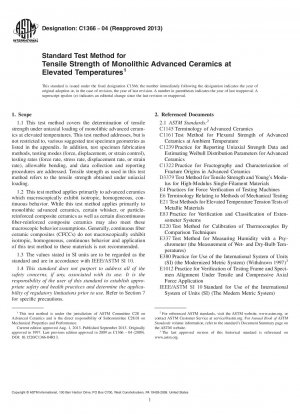ASTM C1366-04(2013)
Standard Test Method for Tensile Strength of Monolithic Advanced Ceramics at Elevated Temperatures
- Standard No.
- ASTM C1366-04(2013)
- Release Date
- 2004
- Published By
- American Society for Testing and Materials (ASTM)
- Status
- Replace By
- ASTM C1366-19
- Latest
- ASTM C1366-19
- Scope
4.1 This test method may be used for material development, material comparison, quality assurance, characterization, reliability assessment, and design data generation.
4.2 High strength, monolithic advanced ceramic materials are generally characterized by small grain sizes (lt; 50 μm) and bulk densities near the theoretical density. These materials are candidates for load-bearing structural applications requiring high degrees of wear and corrosion resistance and elevated-temperature strength. Although flexural test methods are commonly used to evaluate strength of advanced ceramics, the non uniform stress distribution of the flexure specimen limits the volume of material subjected to the maximum applied stress at fracture. Uniaxially-loaded tensile strength tests provide information on strength-limiting flaws from a greater volume of uniformly stressed material.
4.3 Because of the probabilistic strength distributions of brittle materials such as advanced ceramics, a sufficient number of test specimens at each testing condition is required for statistical analysis and eventual design with guidelines for sufficient numbers provided in this test method. Size-scaling effects as discussed in practice C1239 will affect the strength values. Therefore, strengths obtained using different recommended tensile test specimen geometries with different volumes or surface areas of material in the gage sections will be different due to these size differences. Resulting strength values can, in principle, be scaled to an effective volume or effective surface area of unity as discussed in Practice C1239.
4.4 Tensile tests provide information on the strength and deformation of materials under uniaxial stresses. Uniform stress states are required to effectively evaluate any non-linear stress-strain behavior which may develop as the result of testing mode, testing rate, processing or alloying effects, environmental influences, or elevated temperatures. These effects may be consequences of stress corrosion or sub critical (slow) crack growth which can be minimized by testing at appropriately rapid rates as outlined in this test method.
4.5 The results of tensile tests of specimens fabricated to standardized dimensions from a particular material or selected portions of a part, or both, may not totally represent the strength and deformation properties of the entire, full-size end product or its in-service behavior in different environments.
4.6 For quality control purposes, results derived from standardized tensile test specimens can be considered to be indicative of the response of the material from which they were taken for particular primary processing conditions and post-processing heat treatments.
4.7 The tensile strength of a ceramic material is dependent on both its inherent resistance to fracture and the presence of flaws. Analysis of fracture surfaces and fractography as described in Practice C1322 and MIL-HDBK-790, though beyond the scope of this test method, are recommended for all purposes, especially for design data.
1.1 This test method covers the determination of tensile strength under uniaxial loading of monolithic advanced ceramics at elevated temperatures. This test method addresses, but is not restricted to, various suggested test specimen geometries as listed in the appendix. In addition, test specimen fabrication methods, testing modes (force, displacement, or strain control), testing rates (force rate, stress rate, displacement rate, or st......
ASTM C1366-04(2013) Referenced Document
- ASTM C1145 Standard Terminology of Advanced Ceramics
- ASTM C1161 Standard Test Method for Flexural Strength of Advanced Ceramics at Ambient Temperature
- ASTM C1239 Standard Practice for Reporting Uniaxial Strength Data and Estimating Weibull Distribution Parameters for Advanced Ceramics
- ASTM C1322 Standard Practice for Fractography and Characterization of Fracture Origins in Advanced Ceramics
- ASTM D3379 Standard Test Method for Tensile Strength and Young's Modulus for High-Modulus Single-Filament Materials
- ASTM E1012 Standard Practice for Verification of Specimen Alignment Under Tensile Loading
- ASTM E21 Standard Test Methods for Elevated Temperature Tension Tests of Metallic Materials
- ASTM E220 Standard Test Method for Calibration of Thermocouples By Comparison Techniques
- ASTM E337 Standard Test Method for Measuring Humidity with a Psychrometer (the Measurement of Wet- and Dry-Bulb Temperatures)
- ASTM E380 Standard Practice for Use of the Internation System of Units (SI) (the Modernized Metric System)
- ASTM E4 Standard Practices for Force Verification of Testing Machines
- ASTM E6 Standard Terminology Relating to Methods of Mechanical Testing
- ASTM E83 Standard Practice for Verification and Classification of Extensometer
- IEEE/ASTM SI 10 American National Standard for Metric Practice
ASTM C1366-04(2013) history
- 2019 ASTM C1366-19 Standard Test Method for Tensile Strength of Monolithic Advanced Ceramics at Elevated Temperatures
- 2004 ASTM C1366-04(2013) Standard Test Method for Tensile Strength of Monolithic Advanced Ceramics at Elevated Temperatures
- 2004 ASTM C1366-04(2009) Standard Test Method for Tensile Strength of Monolithic Advanced Ceramics at Elevated Temperatures
- 2004 ASTM C1366-04 Standard Test Method for Tensile Strength of Monolithic Advanced Ceramics at Elevated Temperatures
- 1997 ASTM C1366-97 Standard Test Method for Tensile Strength of Monolithic Advanced Ceramics at Elevated Temperatures

Copyright ©2024 All Rights Reserved